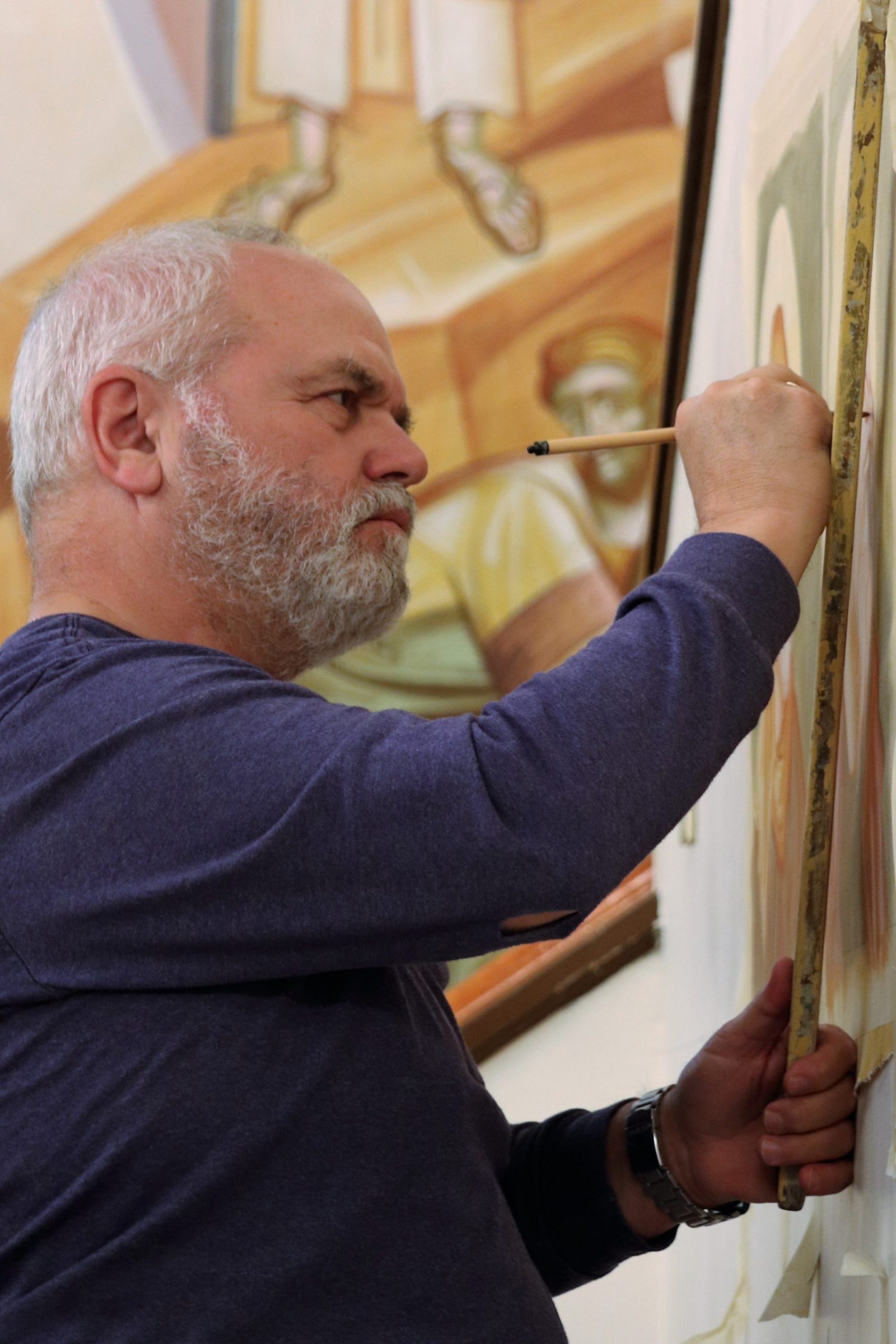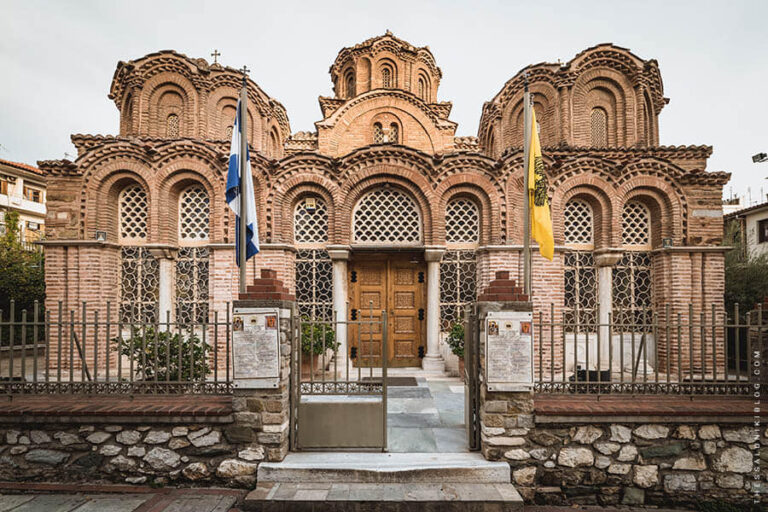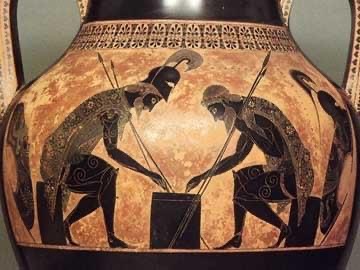GEORGE KORDIS
My painting does not aim to express the essence of reality, human sentiments or feelings, nor does it claim to present a subjective description of what my eyes see in the world. It isn’t a kind of expressionism or surrealism, although it has much in common with these modernist stylistic movements. My painting cannot be categorized within the framework of modern Western art because it is grounded in a different cultural framework, that of Greek-Byzantine art, where painting and its function are conceived of in an entirely different way.
Painting concerns the surface (epiphaneia) of objects. The epiphaneia, however, is not simply a surface, nor is it a vacuum or an empty space. Rather, in Byzantine art the epiphaneia is the manifestation of the hypostasis of the depicted object, which is at once both revealed and hidden. Indeed, its existence is revealed while its essence remains hidden.
The aim of my painting is to create an embrace between the depicted object and the viewer. Each artwork is created in direct reference to the viewer. In this way, the beholder becomes part of the artwork and the artwork part of the beholder.
My work does not endeavour to describe feelings or impressions, but rather describes the relationship between the depicted object and the viewer, creating an intimate bond between subject and object. In this relationship there are no defined roles, and the distinction between subject and object collapses. Relationship is all that remains: a state of love, of synousia (of being together), where all boundaries are lost and life becomes a state of eternal communion.
The aim of my art is realized through the traditional principles and ideals of Byzantine painting, and specifically through the Byzantine principle of rhythm. Everything in a picture is energy: line, colour, movement, and so on. In Byzantine art, these energies are reconciled and exist in a ‘perfect’ way, that is, in a state of dynamic balance. Through rhythm, images become manifestations of a state of love and create a peaceful space-time here on Earth. Rhythm transforms everything into a new reality and manifests a desire for a new world where conflict and hatred are replaced with love and peace.
This ‘consoling realism’, the term which best characterizes my style of painting, focuses on expressing the needs of contemporary people who are tortured by a lack of communion and relationship, by an abyss of darkness. I work and create to present a consoling picture of communion and love, so greatly needed in today’s world.
-George Kordis, 2016
EDUCATION
1991 – Ph.D. in Theology and Byzantine Aesthetics, National and Kapodistrian University of
Athens, Greece.
1989 – Master of Theology (ThM), Holy Cross Greek Orthodox School of Theology, Boston, MA.
1987-1989 – Studies in Medieval Techniques, School of the Museum of Fine Arts, Boston, MA.
ACADEMIC POSITIONS
2008-2013 – Assistant Professor (Theory of Byzantine Painting and Icon Painting), National and
Kapodistrian University of Athens, School of Theology, Athens, Greece.
2003-2008 – Lecturer (Theory of Byzantine Painting and Icon Painting), National and Kapodistrian
University of Athens, School of Theology, Athens, Greece.
AS VISITING PROFESSOR
2013, 2016, 2018, 2021 – University of Notre Dame, Department of Theology and Institute for
Church Life, IN.
2011, 2012 – University of South Carolina, Arts Department, Columbia, SC.
2008 – Orthodox Institute of Theology and Sacred Arts, St. Petersburg, Russia.
2004-2007 – Yale University, Institute of Sacred Music.
2006-2007 – School of Theology, Department of Fine Art and Conservation, Bucharest, Romania.
2006 – Holy Cross Greek Orthodox School of Theology, Boston, MA.
2006 – Ukrainian National Pedagogical University, Odessa.
2005 – Art and Design University in Cluj-Napoca, Romania.
RECENT SOLO EXHIBITIONS
2022- Homeless Refugees. Digital Painting Installation. Heraklion, Municipal Art Gallery, Basilica of Saint Mark. ( Spring)
2022- Writing the Light. Icons. Museikon. Alba Lulia ( September – November).
2022- Homeless Refugees. Digital Painting Installation. Melina Merkouri. Cultural Centre of Athens Municipality. (September 5-24)
2022- Homeless Refugees. Digital Painting Installation. Museum of Byzantine Culture, Thessaloniki. ( July 12-August 31)
2022- Homeric seashores. Theodoros Stamos Gallery. Municipality of Lefkas. ( July 17-30)
2021-Faces of stones. Painting on Aegean sea and Attiki mountains stones. Mets Arts Centre, Athens, Greece.
2020-Logbook. An artistic dialogue with George Seferis’s poetry. 17 Digital Paintings. Museum of Byzantine Culture of Thessaloniki.
2019 – Writing the Light: Portable Icons 2004-2019. Byzantine and Christian Museum of Athens,
Greece.
2018 – Light of Light: Athos, Byzantium, Ecumene. Belgrade, City Museum (The Residence of
Princess Ljubica).
2017 – Homeric Seashores. National and Archaeological Museum of Athens, Greece.
2017 – Athos, Byzantium, Ecumene. Agioriteiki Estia, Thessaloniki, Greece.
2016 – Museum of World Religions, Taipei, Taiwan.
2015 – National Museum of Romania, Cotroceni Palace, Bucharest, Romania.
2015 – Meklart Gallery, Paris France.
2015 – Desmos Gallery, Paris France.
2015 – Heavenly Beauty on Earth. Bulgarian Cultural Centre, Paris, France.
2015 – The Faces of EROS. The Burroughes, Toronto, ON, Canada.
2014 – 2015 – Between Worlds. The Noyes Museum of Art of Stockton College, Oceanville,
New Jersey.
2013 – Light and Rhythm: Byzantine Icons in the Post-Modern World. Yale, Institute Of
Sacred Music Gallery, New Haven, Connecticut.
2013 – Writing with Light. Malloy Hall Chapel, University of Notre Dame, Notre Dame, IN
2013 – Byzantine Personalities. Theocharakis Foundation, Athens, Greece.
2010 – Of the Unknown Warriors and Heroes. Municipal Gallery of Thessaloniki, Villa
Bianca, Greece.
2010 – The Confession of a Point. Argo Gallery, Athens.
2009 – Painting Exhibition. Municipal Gallery of Kavala, Greece.
2009 – Icons. Alexander Nevsky Cathedral, National Gallery of Bulgaria, Sofia, Bulgaria.
2009 – Painting Exhibition. Amimoni Gallery, Ioannina, Greece
2008 – Eros- Archangel: Exhibition by Georgios Kordis. Yakintheia Summer Festival,
Anogeia, Crete, Greece.
2008 – Municipal Gallery of Drama, Drama, Greece.
2007 – 2008 – A Pictorial Discussion with Nikos Eggonopoulos’ Poetry. Ianos Gallery,
Thessaloniki and Athens, Greece.
2007 – San Lorenzo Basilica, Tomba di Donatello, Florence, Italy.
2007 – George Seferis’ Thrush. Aenaon Gallery, Athens, Greece.
2007 – George Seferis’ Thrush. Sterling Memorial Library, Memorabilia Room, Yale
University.
2006 – The Passion According to St. Matthew. Aenaon Gallery, Athens, Greece.
2005 – 2006 – A Pictorial Approach to the Poetry of Nikos Kavadias. Ianos Gallery,
Thesssaloniki and Athens, Greece.
2005 – The Chamber of the Innocent. Aenaon Gallery, Athens, Greece.
SELECT COMMISSIONS – WALL PAINTINGS
- Dormition of the Virgin Mary, Agios Stefanos, Attiki, Greece.
- Prophet Elias Greek Orthodox Church, Frankfurt, Germany.
- Dormition of Theotokos Orthodox Church, North Altona, Melbourne, Australia.
- St. George Orthodox Church, Fishers, Indiana.
- Church of Presentation of Christ at the Temple (Faneromeni), Athens, Greece.
- Church of the Dormition of Mary, Gerakas, Greece.
- Monastery of Docheiariou, Mount Athos.
- The Sign of the Theotokos Church, Montreal, Canada.
- Church of the Holy Trinity, Columbia, SC.
AWARDS
2015 – State of South Carolina, House of Representatives, Commendation and Recommendations for his artistic efforts on the decoration of the Church of Holy Trinity, Columbia, SC.
INTERNATIONAL SYMPOSIA (Organiser and Participant)
2014 – BYZANTIUM: Ottawa International Byzantine Arts Symposium, Ottawa, Ontario, Canada
(Lecturer and Organizer).
2012 – 5th International Symposium of Ecclesiastical Arts, Bucharest, Romania.
2011 – 4th International Symposium of Ecclesiastical Arts, New Valamo Monastery,
Finland.
2010 – 3rd International Symposium of Ecclesiastical Arts, Orthodox Institute of Ecclesiastical Arts,
St. Petersburg, Russia.
2010 – 2nd Atelier international de pictura bisericeasca, Iassi, Romania.
2009 – 1st International Symposium of Ecclesiastical Painting, School of Theology,
University of Thessaloniki, Greece.
PUBLICATIONS
2010 – Egg Tempera: Colour as Light in Byzantine Painting (Athens: Armos).
2007 – The Character of and Reason for Abstraction in Byzantine Painting (Athens:
Armos).
2006 – The ‘Hermeneia’ of Dionysios of Fourna: An Aesthetic and Artistic Response
(Athens: Armos).
2006 – Tradition and Creativity in the Work of Fotis Kontoglou (Athens: Armos).
2005 – On the Character of Greek Folk Art (Athens: Armos).
2002 – The Iconology of St. Photius and Sacred Art in the Post-Iconoclast Period (Athens:
Armos).
2001 – Greek Folk Painting as Consolation (Athens: Armos).
2001- Fayum Portraits and Byzantine Icons (Athens: Armos).
2000 – Icons (Athens: Armos).
2000 – The Icon as Communion (Athens: Armos). Translated in English (Holy Cross
Publications), Serbian, Romanian, Finish, Russian, Spanish and French.
1998 – Faces in the Icons of Theophan the Cretan and the Use of Color: An Aesthetic
Reading (Athens: Armos).
PUBLICATIONS ABOUT THE ARTIST
2017 – Weyl Carr, A. “For George Kordis.” In: The Light of the World: Pictorial Solace with
Icons of Saints of Mount Athos: 26-34.
2017 – Semoglou, T. “Icons of prayer.” In: The Light of the World. Pictorial Solace with
Icons of Saints of Mount Athos: 36-39.
2017 – Wolfe, J. “George Kordis Hagiorite Saints. The Ten Frontal Icons.” In: The Light of
the World: Pictorial Solace with Icons of Saints of Mount Athos: 45-47.
2010 – Trivizadaki, A., “Georgios Kordis on the 1821 Revolution.” In: Georgios Kordis: Of
the Unknown Warriors and Heroes (Exhibition Catalogue). Municipal Gallery of Thessaloniki.
2010 – Gakis, V., “On the Work of Georgios Kordis.” In: Georgios Kordis: Of the Unknown
Warriors and Heroes (Exhibition Catalogue). Municipal Gallery of Thessaloniki.
2010 – Heliopoulou, R. O. “Introduction”, in Georgios Kordis: The Confession of a Point
(Exhibition Catalogue). Argo Gallery.
2009 – Shina, A., “Introduction.” In Georgios Kordis: Of the Unknown Warriors and
Heroes (Exhibition Catalogue). Ellinogermaniki Agogi (Athens) 2010.
2007 – Shina, A.,“Introduction.” In: The Fleeting Dreams of Joy: A Pictorial Discussion
with the Poetry of Nikos Eggonopoulos (Thessaloniki: Ianos).
2007 – Nelson, Robert, S., “George Seferis’ Thrush in Painting: An Exhibit by Artist
Georgios Kordis.” In: George Seferis’ Thrush in Painting (Exhibition Catalogue).Yale University.
2007 – Zouraris, K., “Georgios Kordis: Personifications.” In: Georgios Kordis: Catalogue
(Athens: Armos).
1996 – Tzotzola, V., “Achlios, Kichli, Kyklia.” In: George Seferis’ Thrush: A Pictorial
Approach by Georgios Kordis (Athens: Armos).
1995 – Triantafyllopoulos, N. “Contemporary and Old Art.” In: Enopia Pamfanoonta
(Exhibition Catalogue), (Athens: Armos).
1994 – Zias, N. “Georgios Kordis on Fotis Kontoglou.” In: Enopia Pamfanoonta (Exhibition
Catalogue), (Athens: Armos).
1993 – Zias, N., “Georgios Kordis’ Painting and the Transformation of Everyday Life.” In
Georgios Kordis: Painting (Athens: Armos).
1993 – Plessa, E., “Georgios Kordis: From the Spiritual to the Earthly”, Δελτίο Διοικήσεως
Επιχειρήσεων: 33, 285.
1993 – Xinopoulos, K., G., “The Icon Painting Work of Georgios Kordis.” Introduction in:
Christmas Short Stories (Athens: Armos).
George Kordis is a Member of the Chamber of Fine Art of Greece (C.C.A.G.)




